Holly trees are among the most iconic and versatile plants found in gardens, landscapes, and natural forests around the world. Known for their glossy green leaves and bright red berries, these evergreen and deciduous trees bring year-round interest, especially during the winter season. With their striking appearance and symbolic significance, they are a favorite in both ornamental planting and holiday traditions.
There are many different types of holly trees, each with unique characteristics in leaf shape, berry color, size, and hardiness. From the traditional English Holly to lesser-known species like the Hawaiian Holly or Himalayan Holly, these plants can be found across a wide range of climates and habitats. Some grow as compact shrubs, while others reach tree-like heights, making them suitable for various landscaping needs.
In this guide, you’ll discover 37 types of holly trees, complete with detailed identification tips, pictures, and growing advice. Whether you’re planning a privacy hedge, a decorative focal point, or simply curious about these fascinating trees, this list will help you choose the best holly variety for your region and garden design.
Different Types of Holly Trees
Ilex aquifolium (English Holly)
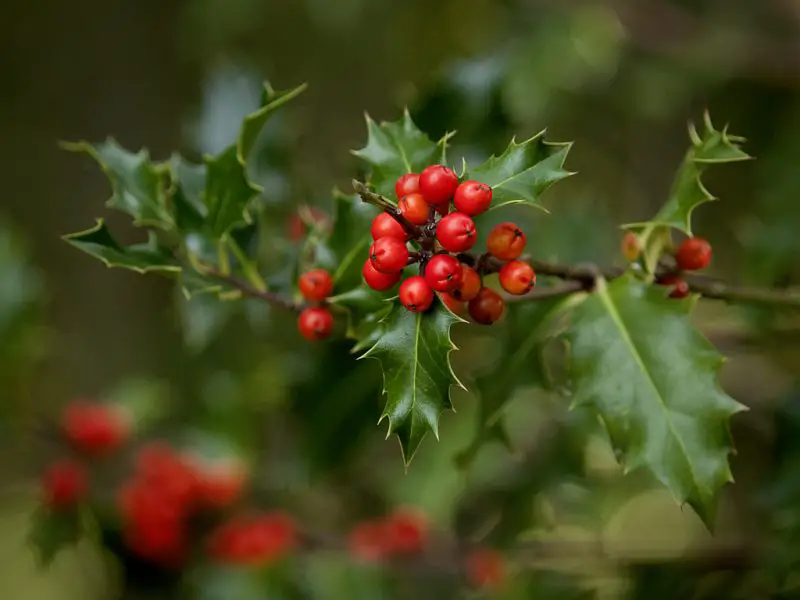
English Holly is a classic evergreen shrub or small tree known for its glossy, spiny, dark green leaves and bright red berries that persist through winter. This species is dioecious, meaning male and female flowers grow on separate plants, and berries only form on female plants with a male pollinator nearby. It typically reaches 15 to 50 feet tall, forming a dense, pyramidal shape ideal for ornamental landscapes.
Native to Europe, English Holly thrives in USDA hardiness zones 6 to 9. It prefers moist, well-drained, slightly acidic soil and grows best in partial shade to full sun. While it tolerates pruning and shaping well, its sharp leaves make handling with gloves advisable. In colder climates, it may need winter protection from strong winds.
English Holly is widely used for holiday decorations, hedging, and wildlife gardens due to its festive berries and evergreen foliage. To ensure fruit production, plant both male and female specimens. Mulch annually to retain moisture, and water during dry periods. Fertilize in spring with a balanced, slow-release fertilizer to encourage healthy growth.
Ilex opaca (American Holly)
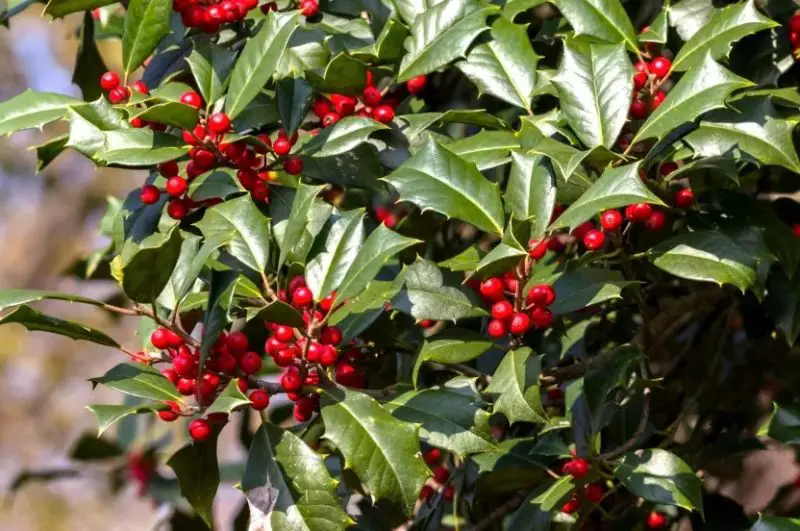
American Holly is a native North American evergreen tree that resembles English Holly in appearance but has duller, softer green leaves with fewer spines. It grows upright with a conical shape, reaching 15 to 30 feet tall in landscapes but can grow taller in the wild. Its red berries are a favorite winter food source for birds and small mammals.
This species is hardy in USDA zones 5 to 9 and is especially popular in the southeastern United States. American Holly prefers acidic, well-drained soils and performs well in both full sun and partial shade. It is relatively drought-tolerant once established and exhibits good resistance to pests and disease.
Commonly planted as a specimen tree, screen, or hedge, American Holly offers year-round structure and wildlife value. Plant one male for every three to five female trees to ensure berry production. Prune in late winter or early spring to maintain shape. Water regularly during the first few years and apply mulch to protect shallow roots.
Ilex cornuta (Chinese Holly)
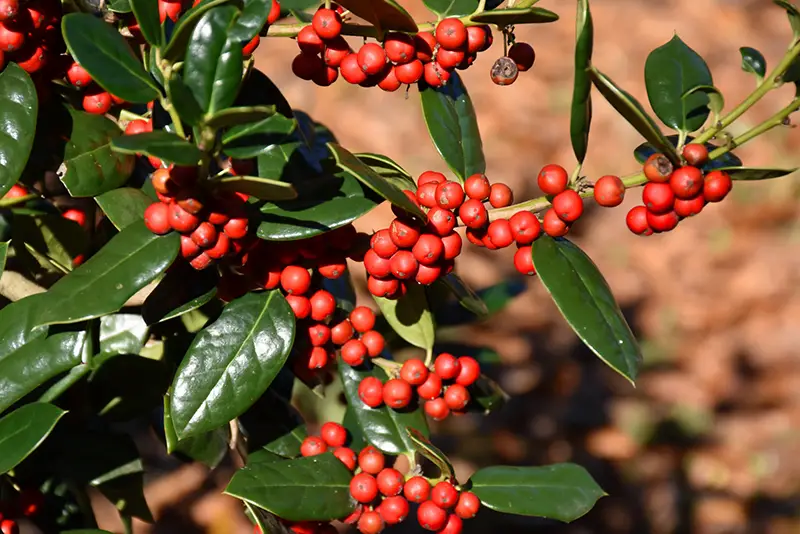
Chinese Holly is an evergreen shrub native to East Asia, notable for its deeply spined, glossy leaves and large, bright red berries. Unlike most hollies, many cultivars of Ilex cornuta are self-fertile, meaning they can produce berries without a male pollinator. It typically grows 8 to 15 feet tall and forms a dense, rounded shape.
Chinese Holly is well suited to USDA zones 7 to 9, where it adapts to a wide range of soil types, including clay and poor soils. It thrives in full sun and tolerates heat and drought once established, making it an excellent choice for southern landscapes. The foliage remains vibrant year-round, and it is often deer-resistant.
This holly is used for foundation plantings, privacy screens, and barrier hedges due to its thorny leaves and dense growth. Popular cultivars include ‘Burfordii’ and ‘Dwarf Burford.’ Prune after flowering if shaping is needed. Water during extended dry spells and fertilize annually with an acid-loving plant formula.
Ilex crenata (Japanese Holly)
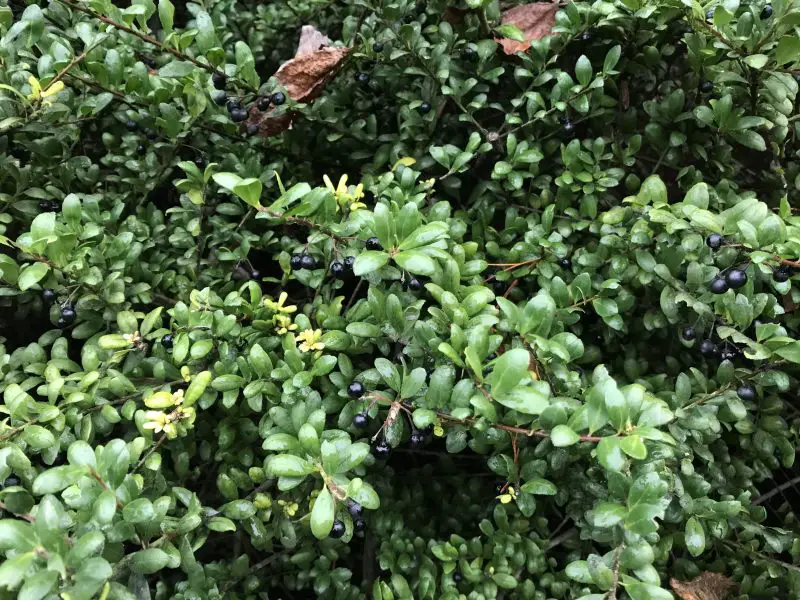
Japanese Holly is an evergreen shrub that resembles boxwood, with small, rounded, spineless leaves and a dense, compact form. It produces small black berries instead of the typical red and is often used as a boxwood substitute in formal hedges and topiaries. It ranges in size from 3 to 10 feet depending on the variety and growing conditions.
Hardy in USDA zones 5 to 8, Japanese Holly thrives in acidic, well-drained soil and prefers full sun to partial shade. It does not tolerate alkaline soils and may develop chlorosis (yellowing leaves) if soil pH is too high. It is slow-growing but very adaptable to shearing and shaping, making it popular in structured garden designs.
This species is ideal for borders, low hedges, and foundation plantings. Cultivars like ‘Sky Pencil’ offer upright, columnar growth perfect for narrow spaces. Water regularly during establishment and avoid planting in wet or poorly draining soils. A spring feeding with balanced fertilizer will support healthy foliage.
Ilex verticillata (Winterberry)
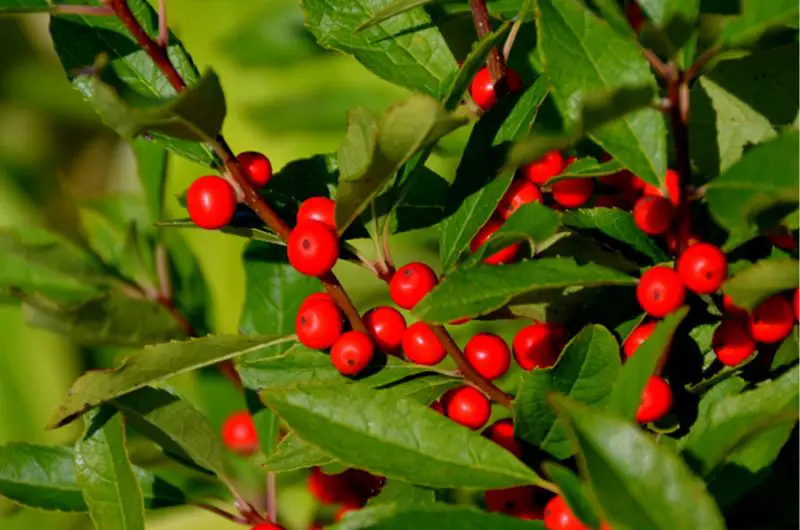
Winterberry is a deciduous holly that stands out for its vivid red berries, which cling to bare branches in winter after the leaves fall. It grows 6 to 10 feet tall and features oval, toothed leaves that turn yellow before dropping in autumn. Unlike evergreen hollies, its striking berry display offers visual interest when little else is in bloom.
Native to North America, Winterberry is hardy in USDA zones 3 to 9 and tolerates a wide range of conditions, including wet and boggy soils. It prefers acidic soil and full sun to partial shade. Since it is dioecious, both male and female plants are required for berry production, with one male able to pollinate several females.
Winterberry is frequently used in rain gardens, naturalized plantings, and cut arrangements. Its berries attract birds and provide essential winter food. Prune in late winter before new growth appears and remove suckers to maintain shape. Mulch and water during dry spells, and use an acidic fertilizer in early spring for best results.
Ilex glabra (Inkberry Holly)
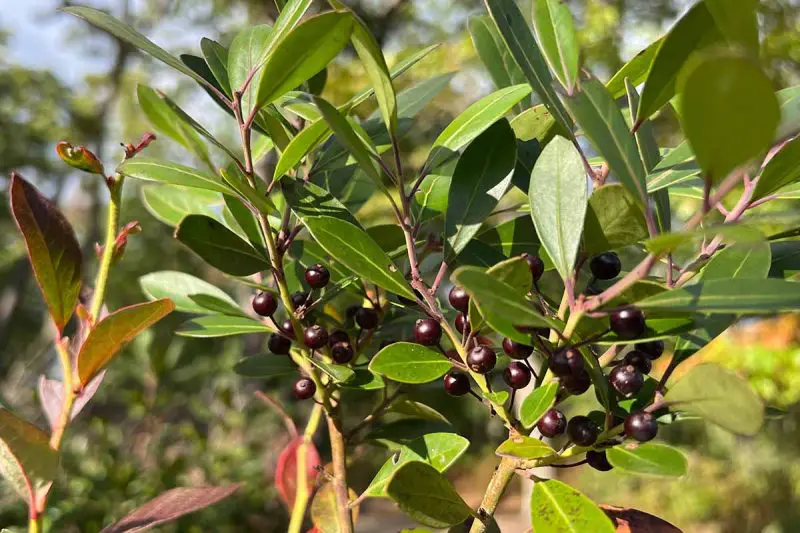
Inkberry Holly is an evergreen shrub native to the eastern United States, known for its smooth, spineless, dark green leaves and small black berries. It typically grows 5 to 8 feet tall and forms a rounded, suckering habit. The dense foliage makes it an excellent alternative to boxwood in hedges and foundation plantings.
This species is hardy in USDA zones 4 to 9 and thrives in moist, acidic soils, including sandy or swampy locations. It tolerates wet conditions and is often found naturally in bogs and along streams. Inkberry prefers full sun to partial shade and may become leggy if not pruned or planted in too much shade.
Inkberry is ideal for low-maintenance hedges, native plant gardens, and wildlife-friendly landscapes. It is dioecious, so both male and female plants are needed for berry production. Prune in early spring to maintain a compact shape and encourage new growth. Apply mulch to retain moisture and fertilize annually with an acid-based formula.
Ilex decidua (Possumhaw)
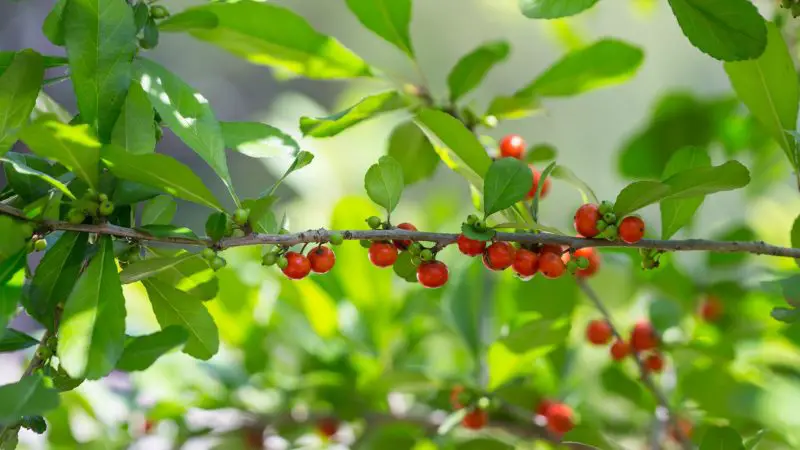
Possumhaw is a deciduous holly native to the southeastern and south-central U.S., recognized for its brilliant red berries that cling to bare winter branches. The shrub or small tree grows 10 to 20 feet tall and wide, with a vase-shaped habit and gray bark that contrasts beautifully with the berries during winter.
Hardy in USDA zones 5 to 9, Possumhaw tolerates a variety of soils, including clay and sandy types, but prefers moist, well-drained conditions. It does well in full sun to partial shade and is quite drought-tolerant once established. Its adaptability and striking winter interest make it a standout in native gardens.
Often planted for ornamental value and wildlife attraction, Possumhaw provides essential food for birds during the colder months. Plant at least one male plant to pollinate nearby females for berry production. Minimal pruning is needed, though shaping can be done in late winter. Mulch and occasional watering will support optimal health.
Ilex vomitoria (Yaupon Holly)
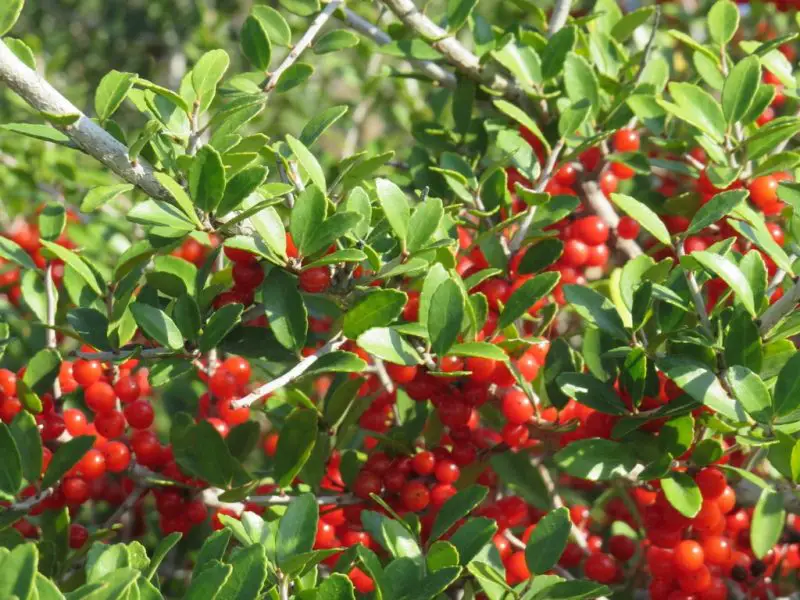
Yaupon Holly is a versatile evergreen shrub or small tree native to the southeastern U.S., notable for its small, leathery leaves and red berries. It reaches 15 to 25 feet tall if unpruned but can be kept much shorter as a hedge. Despite its scientific name, the leaves contain caffeine and are used to brew a traditional tea.
This species thrives in USDA zones 7 to 10 and adapts to a wide range of soil types, including sandy, loamy, or even salty coastal soils. It tolerates drought, humidity, and pruning well, making it a popular landscape plant in warm climates. Full sun to partial shade is ideal for strong growth and berry production.
Yaupon Holly is used in screens, hedges, and naturalistic plantings. Cultivars like ‘Schilling’s Dwarf’ and ‘Pride of Houston’ offer diverse sizes and forms. Plant both male and female specimens for berries. Prune to shape after flowering, and water regularly during dry periods. It requires little fertilization but benefits from organic mulch.
Ilex paraguariensis (Yerba Mate)
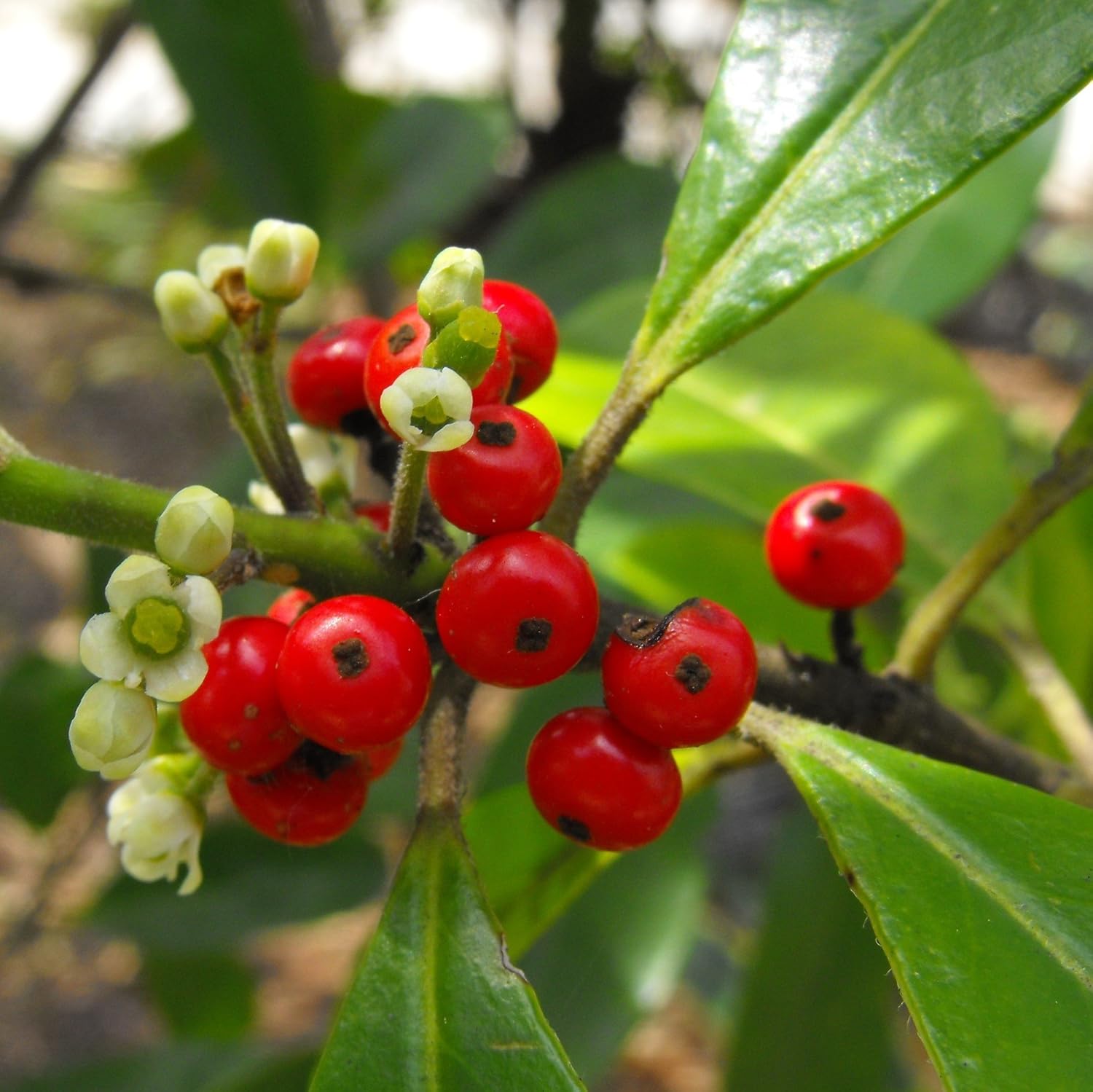
Yerba Mate is a subtropical holly native to South America, best known for its caffeinated leaves that are used to make a popular herbal beverage. It is an evergreen tree growing up to 20 to 50 feet tall in its native habitat, with serrated, glossy green leaves and small white flowers. The leaves are rich in xanthines like caffeine and theobromine.
Yerba Mate grows best in USDA zones 9 to 11 and requires a warm, humid climate with regular rainfall. It prefers fertile, well-drained, slightly acidic soil and full sun. In cooler climates, it must be grown in greenhouses or containers that can be moved indoors during the winter. Young trees are sensitive to frost and wind.
Cultivated primarily for its leaves, Yerba Mate is harvested by drying and aging the foliage, which is then steeped in hot water to create the famous drink. The tree can also be used ornamentally in subtropical gardens. Regular pruning encourages bushier growth and easier harvesting. Provide ample water and organic mulch to retain moisture.
Ilex × meserveae (Blue Holly hybrids)
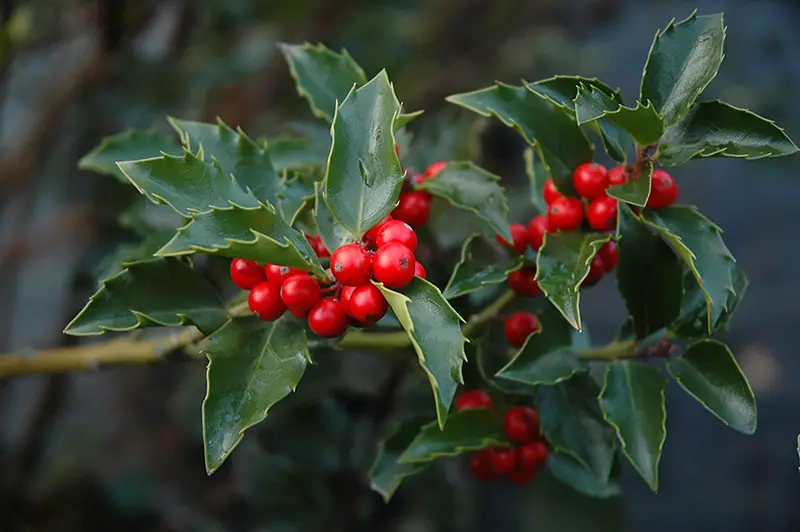
Blue Holly refers to a group of hybrid hollies developed by crossing Ilex aquifolium with Ilex rugosa, resulting in cold-hardy evergreen shrubs with striking blue-green foliage and red berries. These hybrids are prized for their ornamental value and winter resilience. Most varieties grow 6 to 10 feet tall with a dense, upright habit.
These cultivars are hardy in USDA zones 5 to 7, making them suitable for colder climates where other evergreen hollies struggle. They prefer well-drained, acidic soil and grow best in full sun to partial shade. The leaves are slightly spiny and have a distinctive bluish tint, adding interest to winter gardens.
Blue Holly varieties such as ‘Blue Prince’ and ‘Blue Princess’ are often planted together to ensure pollination and fruit production. They’re excellent choices for foundation plantings, hedges, and mixed borders. Prune in late winter or early spring to shape, and mulch to conserve moisture. Fertilize in early spring with an acid-loving plant formula.
Ilex serrata (Finetooth Holly)
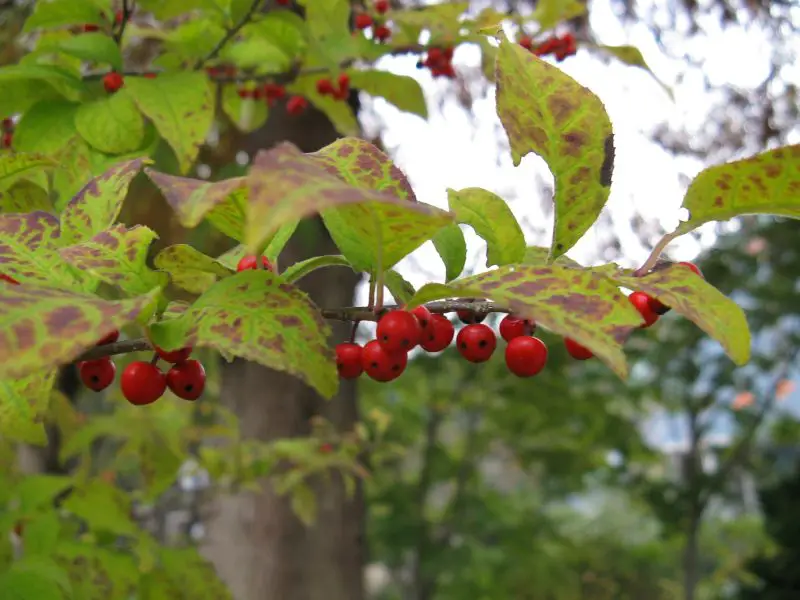
Finetooth Holly is a deciduous shrub or small tree native to Japan and Korea. It features small, finely serrated leaves and bright red berries that persist well into winter. Growing up to 15 feet tall, it displays a graceful, upright branching structure that adds texture and seasonal interest to the landscape.
Hardy in USDA zones 5 to 8, Ilex serrata prefers moist, well-drained, slightly acidic soils. It thrives in full sun to partial shade and is relatively low-maintenance once established. This species is more tolerant of cold than many evergreen hollies and can be used effectively in colder regions with a temperate climate.
Finetooth Holly is often planted for its ornamental fruit, which attracts birds and offers vibrant winter color. Since it is dioecious, you’ll need both male and female plants for berry production. Prune after flowering to maintain shape, and apply mulch to conserve moisture and protect the roots in colder climates.
Ilex pernyi (Perny’s Holly)
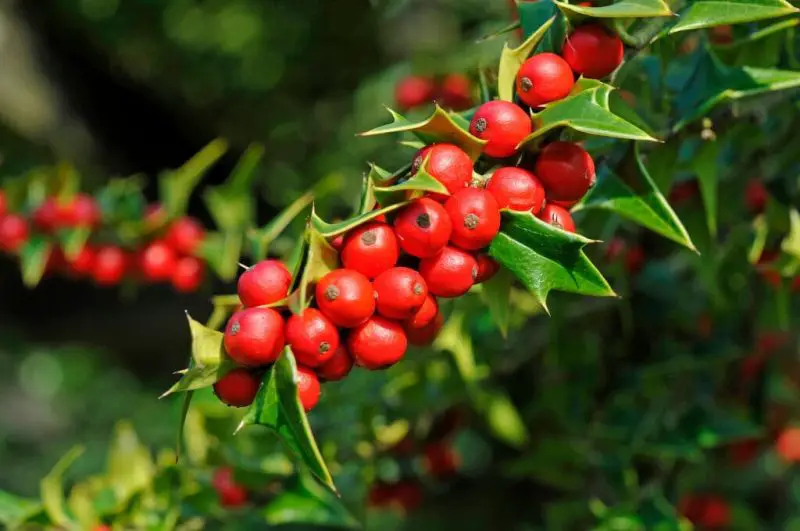
Perny’s Holly is an evergreen holly native to China, known for its small, sharply pointed, leathery leaves and bright red berries. It forms a compact, rounded shrub reaching up to 10 feet tall, and its dense foliage provides year-round greenery in the garden.
It is hardy in USDA zones 6 to 9 and does well in full sun to partial shade. Perny’s Holly prefers well-drained, acidic soils and is adaptable to various garden settings. It is drought-tolerant once established but benefits from consistent watering during prolonged dry spells.
This holly is excellent for foundation plantings, mixed borders, or low privacy hedges. Its sharp leaves offer a natural deterrent to animals, and the berries attract winter birds. To promote fruiting, ensure a male plant is nearby. Light pruning in early spring will keep the shape tidy and encourage new growth.
Ilex latifolia (Tarajo Holly)

Tarajo Holly is a broadleaf evergreen holly native to East Asia, particularly China and Japan. It is easily recognized by its large, glossy, spineless leaves that resemble those of magnolias, and by its bright red berries. It can grow as a tall shrub or small tree, often reaching 20 to 30 feet in height.
Suitable for USDA zones 7 to 9, Tarajo Holly prefers full sun to partial shade and thrives in moist, acidic, well-drained soils. It is both heat- and humidity-tolerant, making it ideal for southern and coastal landscapes. Though it can withstand short cold spells, it may suffer in extended freezing temperatures.
Tarajo Holly is a favored ornamental for parks, campuses, and residential landscapes due to its bold foliage and reliable fruit display. Its berries support wildlife, and the dense form makes it a great choice for privacy screens. Prune in early spring, and provide balanced fertilizer to support its vigorous growth.
Ilex macropoda (Largeleaf Holly)
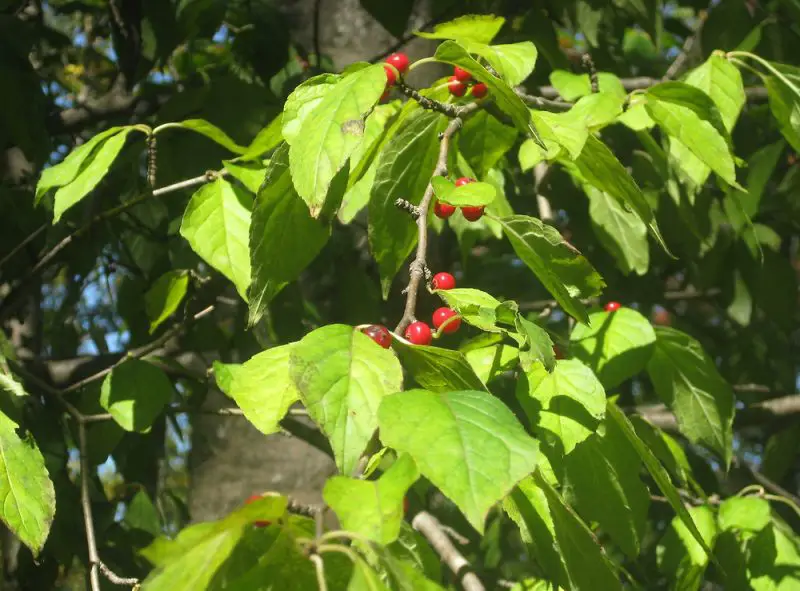
Largeleaf Holly is a deciduous species native to East Asia, named for its noticeably large leaves that are ovate and serrated but not spiny. It grows as a tall shrub or small tree, often reaching up to 30 feet in height, and produces red berries in fall that persist into winter.
This holly is hardy in USDA zones 6 to 9 and prefers a location with full sun to partial shade. It grows best in moist, well-drained, acidic soil and appreciates regular watering during dry spells. The plant is tolerant of urban pollution and can be used in a variety of landscape situations.
Largeleaf Holly is admired for its clean foliage, wildlife-friendly berries, and graceful habit. Because it is dioecious, a male plant is necessary nearby to ensure fruiting on female plants. Pruning should be done in late winter or early spring to shape the plant and remove any damaged or crossing branches.
Ilex mucronata (Mountain Holly)
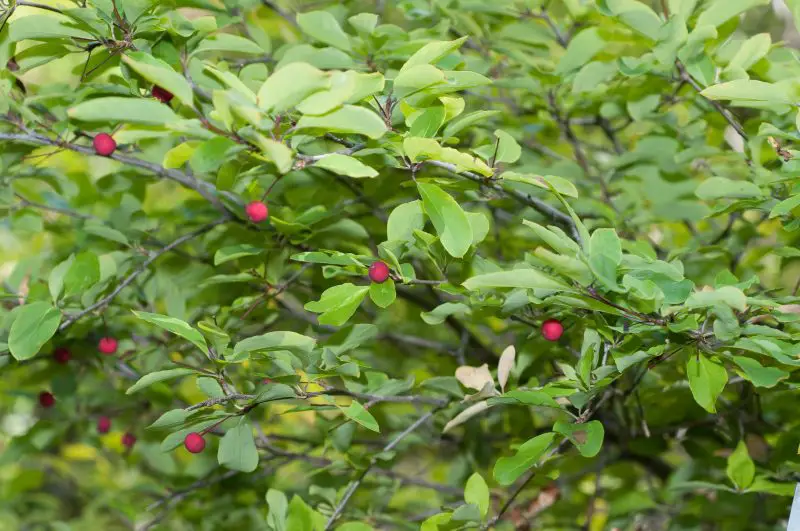
Mountain Holly, previously classified as Nemopanthus mucronatus, is a deciduous holly native to the northeastern United States and eastern Canada. It features simple, alternate leaves with finely serrated edges and produces red berries on female plants that attract birds in fall and winter.
Hardy in USDA zones 4 to 7, Mountain Holly prefers cool, moist, acidic soils and grows naturally in bogs, swamps, and wet woods. It thrives in full sun to partial shade and generally reaches heights of 6 to 10 feet, forming a loose, multi-stemmed habit.
Mountain Holly is used in naturalized plantings, wetland restoration, and native gardens. Its subtle beauty and environmental value make it a favorite among ecologists and native plant enthusiasts. For best results, plant both male and female specimens. Minimal pruning is needed, and mulch helps conserve moisture and control weeds.
Ilex aquifolium ‘Ferox Argentea’ (Silver Hedgehog Holly)
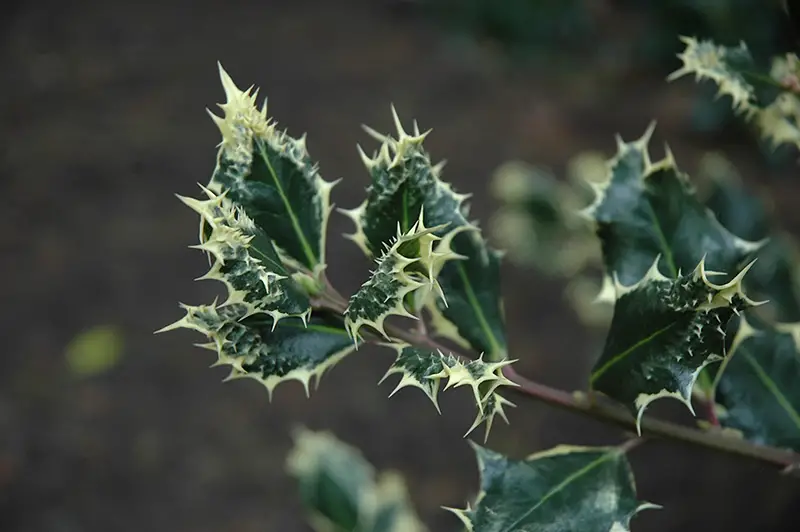
Silver Hedgehog Holly is a striking cultivar of English Holly known for its highly ornamental, spiny foliage. The leaves are deep green with creamy-white margins and an abundance of spines, even on the upper surface, giving it a fierce and distinctive appearance. This evergreen shrub grows slowly, typically reaching 6 to 10 feet tall, and is often used for formal gardens or hedging.
It thrives in USDA hardiness zones 6 to 8 and prefers full sun to partial shade. This cultivar does best in moist, well-drained, acidic soils and is relatively low-maintenance once established. Though slow-growing, it forms a dense, compact shape that can be pruned for topiary or structured hedges.
Silver Hedgehog Holly is ideal for ornamental borders, security hedging, or as a stand-alone specimen due to its unusual foliage. The spiny texture discourages animals, and its variegated color adds brightness in winter landscapes. Prune lightly in early spring to shape, and mulch to retain soil moisture and protect roots.
Ilex aquifolium ‘Argentea Marginata’ (Silver Variegated English Holly)
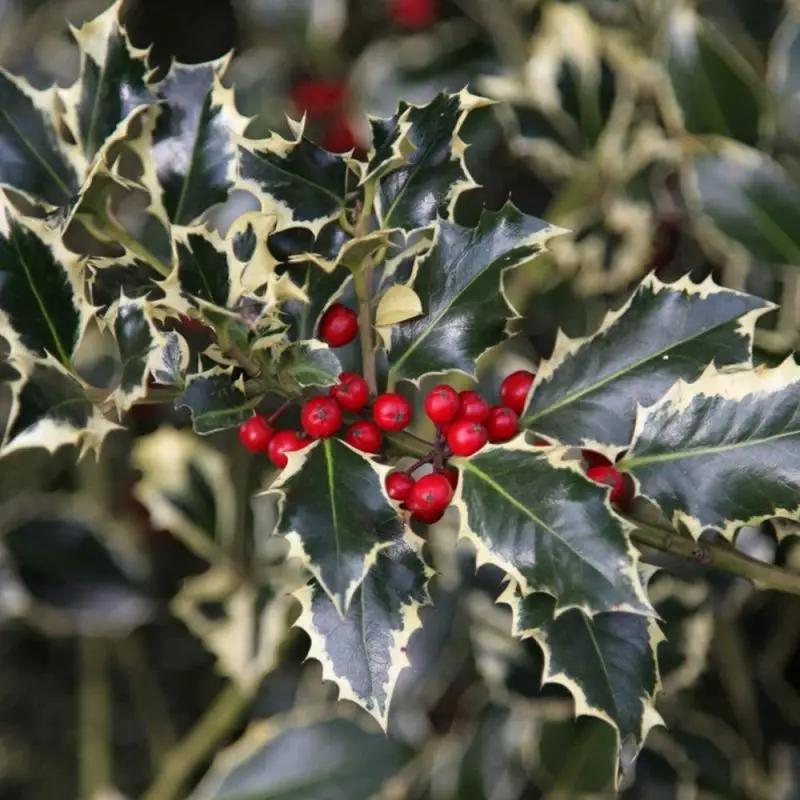
Silver Variegated English Holly is a highly decorative evergreen holly known for its glossy green leaves edged in creamy-white. This cultivar can grow into a tall shrub or small tree, often reaching heights of 15 to 20 feet, and produces clusters of red berries on female plants when a male pollinator is nearby.
Hardy in USDA zones 6 to 8, this holly prefers full sun to partial shade and performs best in slightly acidic, well-drained soil. It is tolerant of urban pollution and coastal conditions, making it versatile for a range of landscapes. It requires moderate watering and benefits from occasional mulching.
Its bold foliage makes it a popular choice for specimen planting, mixed borders, and holiday displays. The red berries attract birds, while the evergreen leaves provide year-round structure and interest. Light pruning in late winter or early spring will help maintain its shape and remove any wayward growth.
Ilex aquifolium ‘Golden Queen’
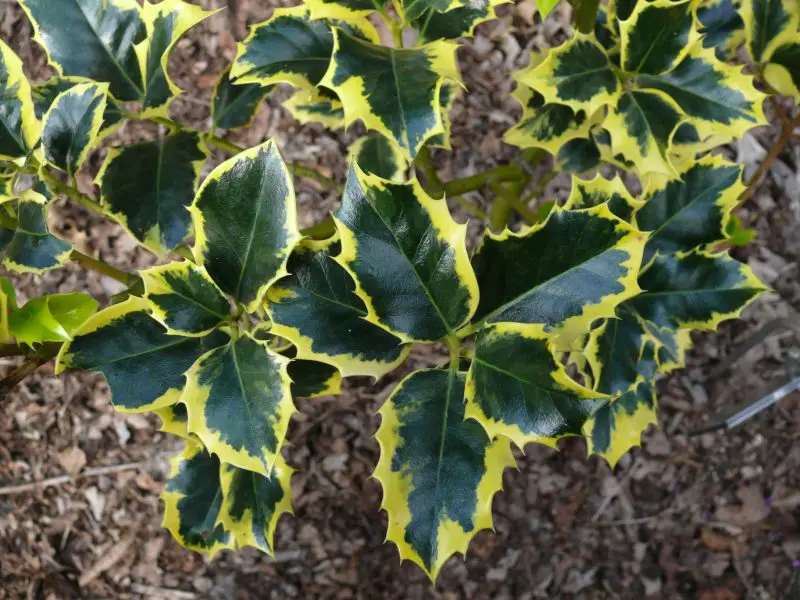
Golden Queen is a female cultivar of English Holly prized for its deep green leaves with bright golden-yellow margins. The foliage is both spiny and glossy, adding a colorful twist to traditional holly forms. It can grow up to 15 feet tall and offers bright red berries in winter if a male pollinator is nearby.
This cultivar thrives in USDA zones 6 to 8 and prefers a site with full sun to partial shade. It performs best in acidic, well-drained soil and requires regular watering until established. Golden Queen is tolerant of coastal winds and urban conditions, making it suitable for varied garden settings.
Golden Queen makes an excellent feature plant, hedge, or backdrop in ornamental gardens. Its variegated foliage provides year-round interest, while the berries add winter color and support wildlife. Prune in early spring to manage its form and promote healthy, vibrant new growth.
Ilex × attenuata ‘Foster’s #2’ (Foster Holly)
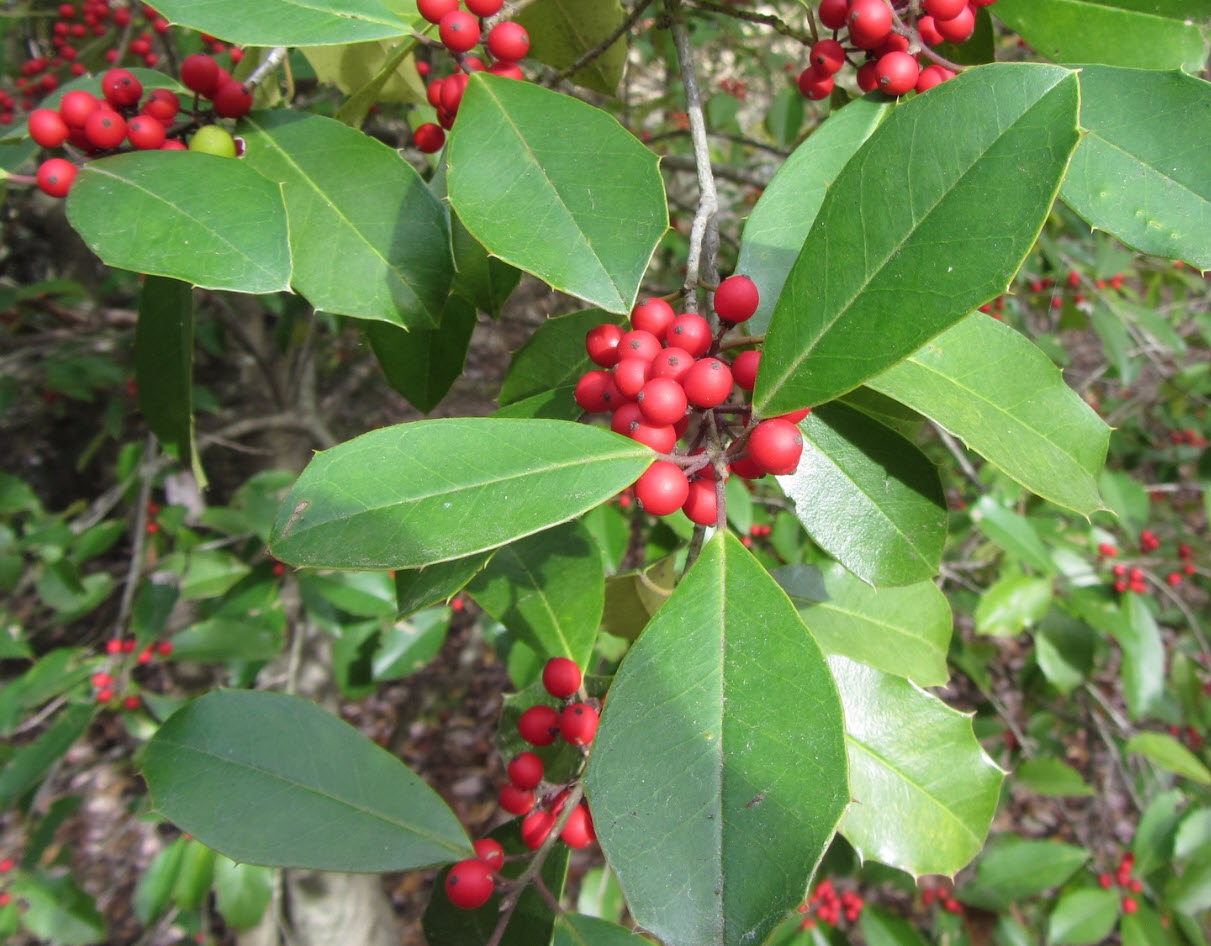
Foster’s #2 Holly is a popular female hybrid cultivar from the Ilex × attenuata group, valued for its narrow, upright growth and profuse berry production. Its small, dark green leaves have few spines, and the plant naturally maintains a pyramidal shape without extensive pruning.
This holly is hardy in USDA zones 6 to 9 and performs well in full sun to light shade. It prefers acidic, well-drained soils and benefits from consistent moisture during establishment. It is relatively fast-growing compared to other hollies and can reach 20 to 25 feet tall at maturity.
Foster’s #2 is ideal for formal plantings, screens, and foundation use due to its neat shape and year-round appeal. The vibrant red berries attract birds and remain well into winter. Although technically self-fertile, proximity to a male holly can boost berry production. Prune in early spring if shaping is needed.
Ilex × attenuata ‘Savannah’
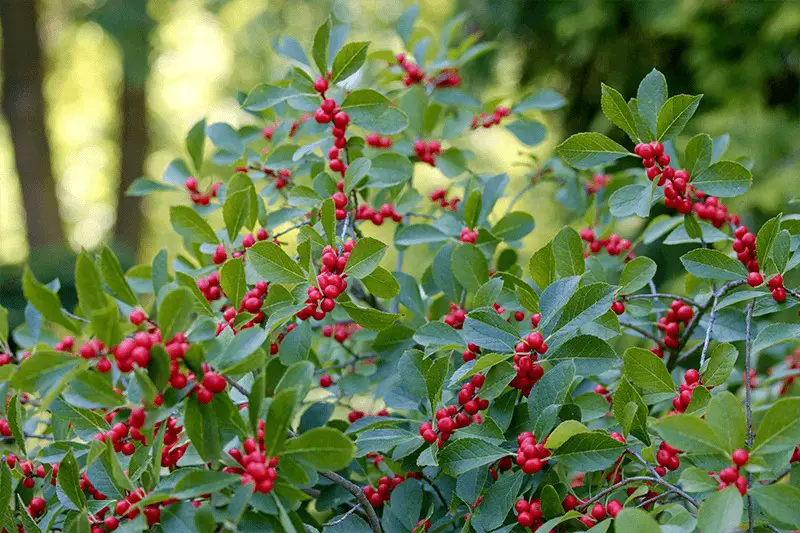
Savannah Holly is another widely planted hybrid cultivar of Ilex × attenuata, appreciated for its graceful, pyramidal habit and dense foliage. It has soft, glossy green leaves with fewer spines and is known for its abundant, bright red berries in fall and winter. It can grow up to 30 feet tall and 10 to 15 feet wide.
Thriving in USDA zones 6 to 9, Savannah Holly does best in full sun to partial shade and requires acidic, well-drained soil. It is relatively drought-tolerant once established and handles southern heat and humidity well. Regular watering during the first few years ensures deep root development.
This holly is popular as a lawn specimen, privacy screen, or hedge, offering both beauty and function. The berries provide winter food for birds, and the evergreen foliage brings structure to the landscape. Minimal pruning is needed thanks to its naturally uniform shape—simply remove any damaged or crossing branches in late winter.
Ilex × attenuata ‘East Palatka’
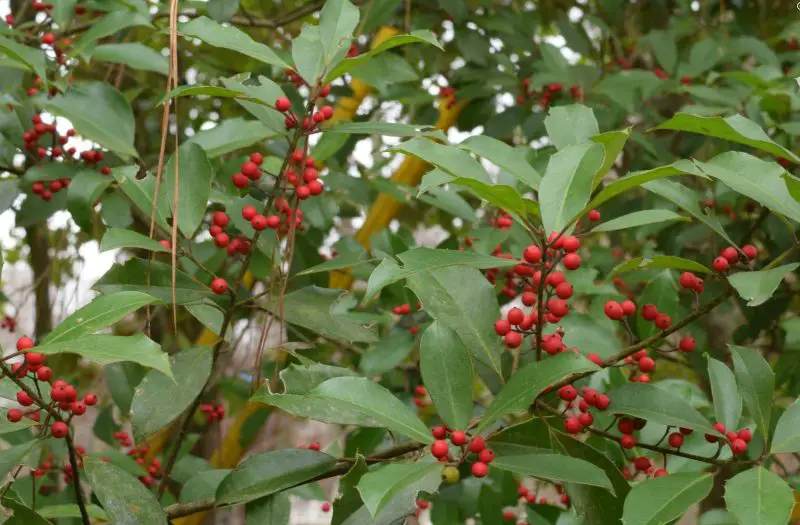
East Palatka Holly is a popular hybrid holly known for its attractive shape and prolific berry production. This female cultivar features elongated, soft-textured leaves with only a few marginal spines, giving it a refined appearance. It grows in a naturally pyramidal form, reaching 20 to 30 feet in height with a spread of 10 to 15 feet.
This holly thrives in USDA zones 6 to 9 and prefers full sun to partial shade. It performs well in slightly acidic, well-drained soils and can tolerate both drought and wet conditions once established. East Palatka is more heat-tolerant than many other hollies, making it a favorite in southern landscapes.
It is widely used in urban landscaping, parks, and residential settings as a specimen tree, screen, or street tree. The red berries attract birds and provide winter interest. Light pruning in early spring is typically enough to maintain its shape, and mulching helps retain moisture and regulate root temperature.
Ilex integra (Moji Holly)
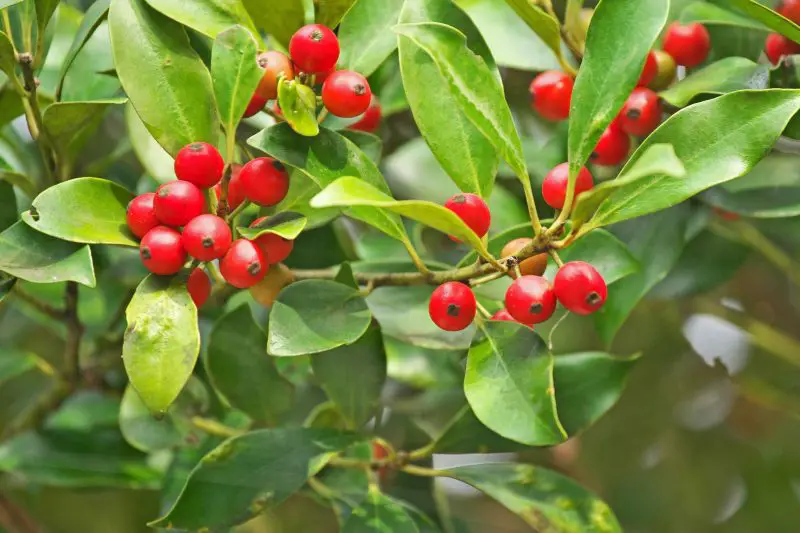
Moji Holly, native to parts of East Asia, is an ornamental evergreen holly with a striking upright form and glossy, deep green leaves. The leaves are oval and slightly serrated without spines, distinguishing it from more traditional hollies. It can grow up to 30 feet tall but is often kept smaller in cultivation.
It grows best in USDA zones 7 to 9 and requires a location with full sun to partial shade. This holly prefers fertile, well-drained soil and appreciates regular watering during establishment. Its tolerance for pruning and neat growth habit make it a favorite for urban and formal landscapes.
Moji Holly is often used for hedging, topiary, or as a vertical accent in gardens. Though less common than other species, its elegant shape and low-maintenance needs make it highly desirable. Prune in late winter or early spring to shape and remove deadwood as needed.
Ilex cassine (Dahoon Holly)
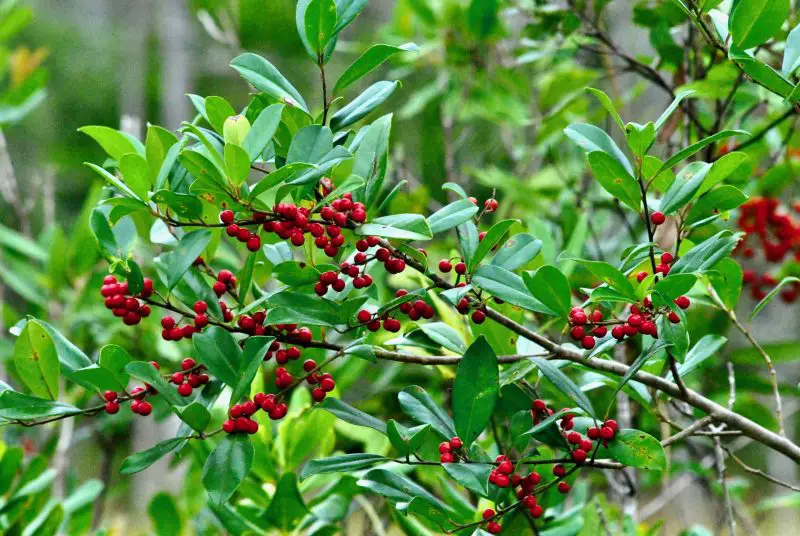
Dahoon Holly is a native evergreen tree of the southeastern United States, recognized for its narrow, shiny green leaves and showy red berries. It has a soft, upright form with smooth gray bark and typically reaches 20 to 30 feet in height. Female trees produce bright red berries that persist into winter.
It is hardy in USDA zones 7 to 10 and thrives in full sun to part shade. Dahoon Holly is highly adaptable to wet sites, making it ideal for rain gardens, pond edges, or swampy areas. It prefers acidic, moist soils and can tolerate seasonal flooding better than most hollies.
This species is a valuable ornamental tree in naturalistic landscapes and wetland restorations. Its berries attract birds and wildlife, and its graceful appearance enhances southern gardens. Minimal pruning is needed, usually just to maintain shape or remove damaged branches.
Ilex cassine var. angustifolia (Narrowleaf Dahoon)

Narrowleaf Dahoon is a naturally occurring variety of Dahoon Holly, known for its slender, more elongated leaves that give it a refined, airy texture. It typically grows as a multi-trunked or single-trunked small tree or large shrub, reaching 15 to 25 feet in height.
This variety is suited for USDA zones 7 to 10 and does well in full sun to light shade. Like the typical species, it tolerates wet soils and is often found in swampy, low-lying areas. It prefers acidic, organically rich soil and benefits from a layer of mulch to preserve soil moisture.
Narrowleaf Dahoon is favored in ornamental landscapes for its graceful form, ornamental berries, and adaptability to wet sites. It’s often planted near water features, in naturalized gardens, or as a screen. Pruning should be done in early spring to shape or remove weak growth.
Ilex chapaensis
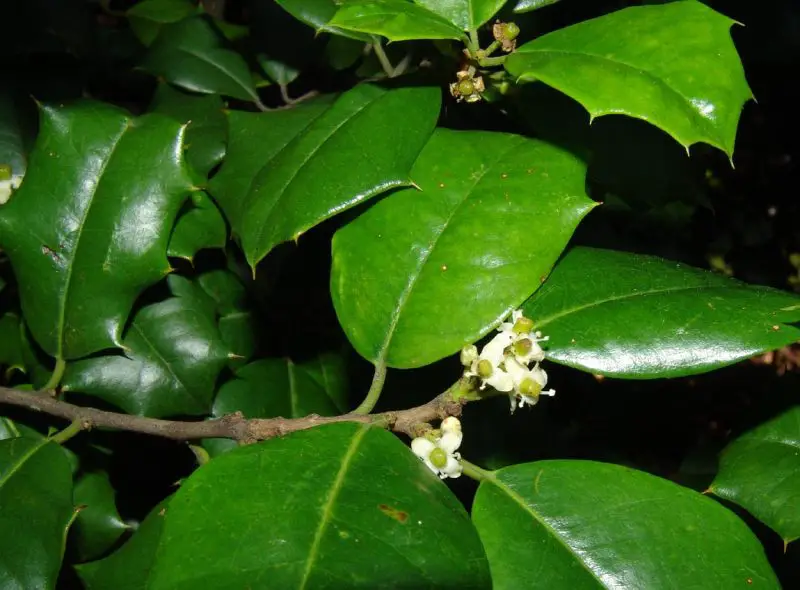
Ilex chapaensis is a lesser-known holly species native to Vietnam and southern China. This small evergreen tree or shrub features leathery, oval-shaped leaves with toothed margins. It is admired for its ornamental form and glossy foliage, with occasional red or orange berries.
It grows in USDA zones 7 to 9 and thrives in full sun to partial shade. Ilex chapaensis prefers well-drained, slightly acidic soil and benefits from regular watering during dry periods. While not widely available, it is gradually being introduced to collectors and botanical gardens.
Due to its rarity, Ilex chapaensis is primarily grown for ornamental or research purposes. It can serve as an attractive specimen plant in mild climates. Light pruning in early spring helps maintain its shape, and mulching aids in protecting roots from extreme temperatures.
Ilex montana (Mountain Winterberry)
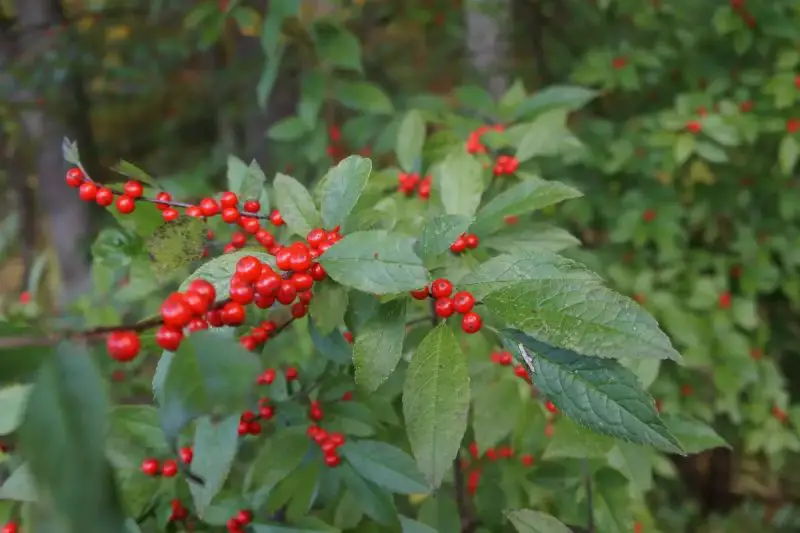
Mountain Winterberry is a deciduous holly native to the Appalachian Mountains of the eastern United States. It grows as a large shrub or small tree, typically reaching 10 to 20 feet tall. The oval leaves turn yellow in fall, and female plants produce bright red berries that persist into winter, creating striking seasonal contrast.
This species thrives in USDA zones 5 to 8 and prefers cool, moist, well-drained soils. It grows best in partial shade but can tolerate full sun in cooler climates. As a deciduous holly, it loses its leaves in winter but maintains ornamental value through its colorful berries and branching form.
Mountain Winterberry is well-suited for naturalized landscapes, woodland edges, and wildlife gardens. Its berries attract birds and other wildlife, and its native status makes it ecologically valuable. Prune in late winter to shape or control size, and ensure cross-pollination by planting male and female plants nearby.
Ilex rugosa (Tsuru Holly)
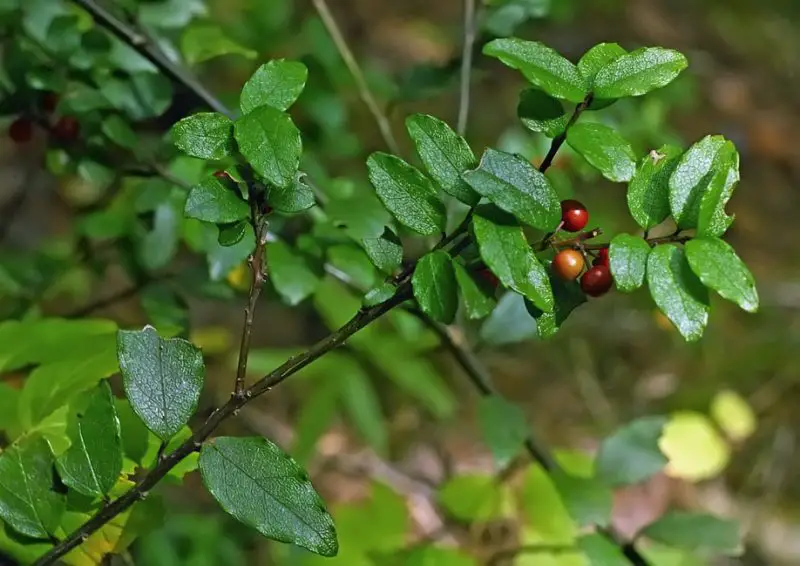
Tsuru Holly is a low-growing, spreading holly species native to Japan and parts of Russia. It features thick, leathery, dark green leaves with toothed margins and grows to about 2 to 4 feet in height with a wider spread. It is particularly valued for its cold hardiness and ground-covering growth habit.
Hardy in USDA zones 3 to 7, Ilex rugosa thrives in cool climates and well-drained, slightly acidic soils. It prefers full sun to part shade and tolerates wind and snow, making it an excellent choice for northern gardens. It requires consistent moisture during the first year of establishment.
This species is often used in breeding programs to create hardy hybrid hollies and is appreciated in gardens as a low-maintenance, compact shrub. It works well in rock gardens, borders, and as erosion control on slopes. Light pruning in spring encourages denser growth and improved shape.
Ilex anomala (Hawaiian Holly)
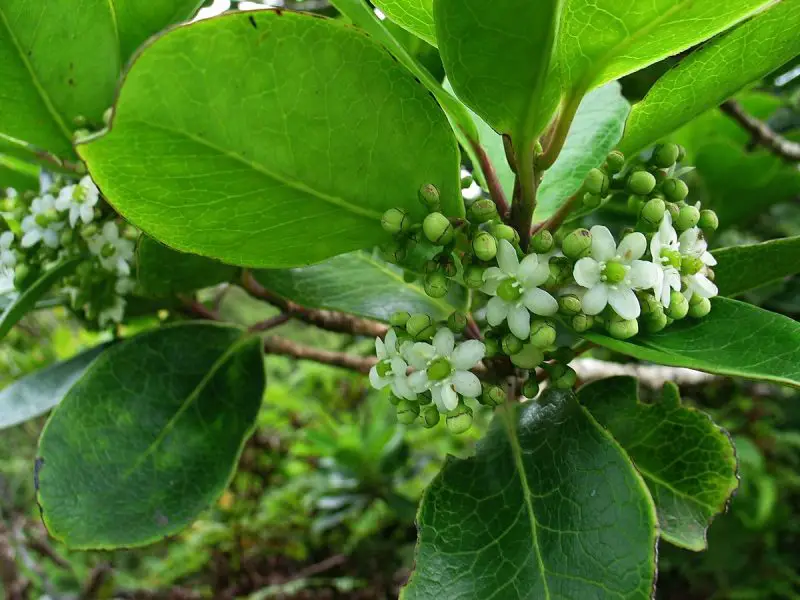
Hawaiian Holly is a rare species endemic to the Hawaiian Islands. Unlike many other hollies, it has smooth-margined, glossy green leaves and often grows as a small tree or tall shrub in rainforest habitats. It can reach heights of 15 to 30 feet in its native environment.
It grows best in USDA zones 10 to 11 and prefers consistently moist, well-drained soil. Hawaiian Holly thrives in partial shade and high humidity, making it suitable only for tropical and subtropical regions. It is not frost-tolerant and should be protected from cold temperatures.
This species is mainly grown for conservation, education, or as a collector’s plant due to its limited natural range. In tropical gardens, it can serve as a specimen tree with minimal pruning required. Regular watering and organic mulch support healthy growth in suitable climates.
Ilex amelanchier

Ilex amelanchier is a rare and little-known holly species native to parts of the southeastern United States. It resembles some deciduous holly species, with elliptical green leaves and small, white flowers followed by red to orange berries. Its form is typically shrubby, reaching 8 to 15 feet tall.
It thrives in USDA zones 6 to 9 and prefers moist, acidic soils in shaded or partially shaded environments. This species is not widely cultivated and is usually found in natural woodland or swampy habitats. It may go dormant in winter and regrow in spring.
Due to its scarcity, Ilex amelanchier is mainly of botanical interest and is not commonly used in landscaping. However, it may be incorporated into native plant gardens or restoration projects. If cultivated, it requires regular moisture and benefits from occasional pruning to manage shape.
Ilex coriacea (Large Gallberry)
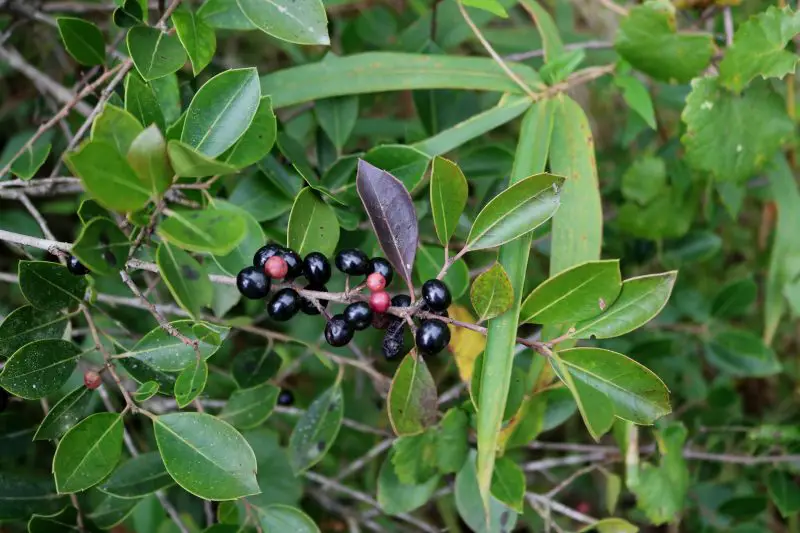
Large Gallberry is an evergreen holly native to the southeastern coastal plain of the United States. It features dark green, oval leaves and small white flowers in spring that attract pollinators. The plant usually grows 6 to 12 feet tall and forms dense thickets in its native habitat.
This species grows well in USDA zones 6 to 9 and is adapted to sandy, acidic soils. It prefers full sun to partial shade and is tolerant of both drought and wet conditions once established. Large Gallberry is particularly common in pine barrens and coastal woodlands.
It is commonly used in beekeeping, as its nectar-rich flowers are excellent for honey production. In landscapes, it serves well as a hedge or naturalized screen. Light pruning can help maintain shape, and mulch can be used to conserve moisture and suppress weeds.
Ilex dipyrena (Himalayan Holly)

Himalayan Holly is an evergreen species native to the Himalayan region, known for its glossy green leaves with lightly toothed margins and small red berries that persist through winter. It typically grows as a small tree or large shrub, reaching up to 20 feet in height. Its attractive foliage and upright habit make it appealing in ornamental landscapes.
This species grows best in USDA zones 7 to 9 and thrives in well-drained, fertile soils. It prefers partial shade but can tolerate full sun if the soil remains moist. In cooler zones, protection from harsh winter winds is beneficial to prevent foliage damage.
Himalayan Holly can be used in mixed shrub borders, woodland gardens, or as a specimen plant. It benefits from light pruning to shape and remove damaged branches. Water regularly during dry periods, and mulch to retain soil moisture and protect roots during colder months.
Ilex theezans (Brazilian Holly)
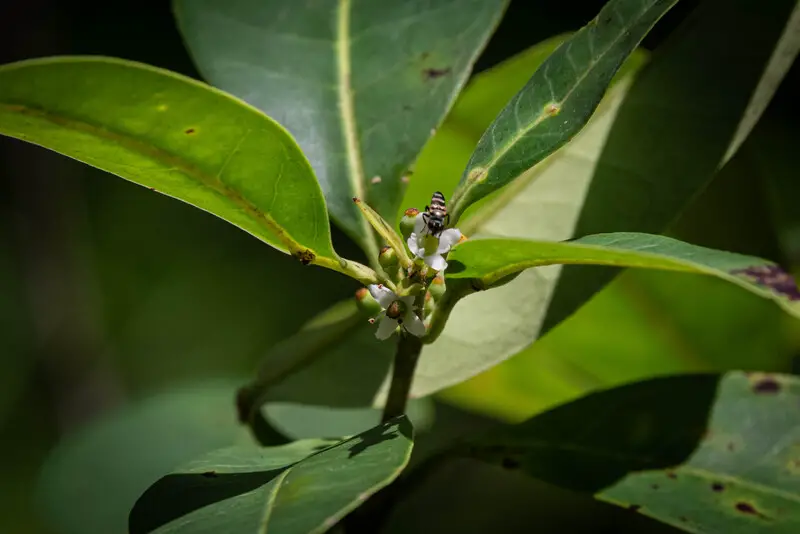
Brazilian Holly is a South American species closely related to Yerba Mate, recognized for its smooth, dark green leaves and bushy growth habit. It typically grows as a small to medium-sized evergreen tree, often reaching 10 to 20 feet tall. Its leaves resemble tea leaves, hence the name “theezans.”
It is suitable for USDA zones 9 to 11, preferring subtropical to tropical climates. Brazilian Holly grows best in slightly acidic, well-drained soils and thrives in full sun to partial shade. It is frost-sensitive and not well-suited to areas with cold winters.
This holly is often grown for ornamental use or in reforestation efforts in its native range. It requires little maintenance once established but appreciates regular watering in dry periods. Pruning can be done in late winter or early spring to control shape and encourage denser growth.
Ilex brasiliensis
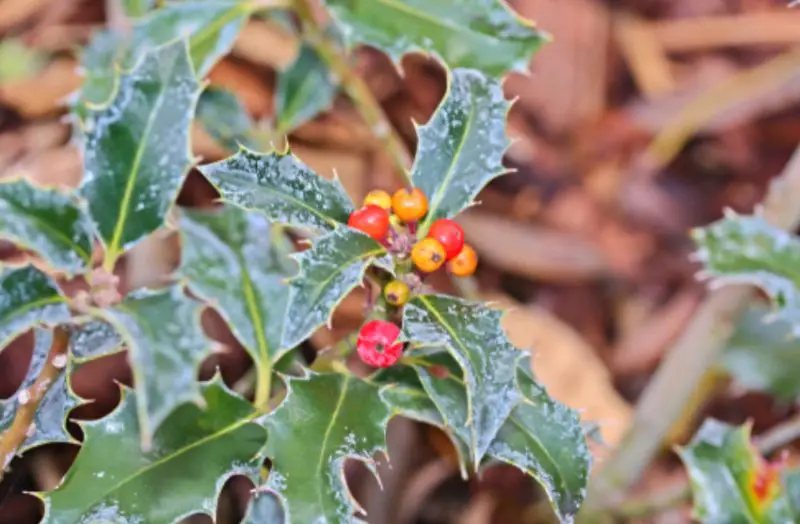
Ilex brasiliensis is a lesser-known holly species native to Brazil and other parts of South America. It is an evergreen shrub or small tree with narrow, leathery green leaves and inconspicuous white flowers followed by dark berries. Its natural growth form is loose and upright.
This species grows in USDA zones 9 to 11 and thrives in warm, humid environments. It prefers rich, well-drained soil and can tolerate both full sun and partial shade. Like many tropical hollies, it is sensitive to frost and requires protection in cooler climates.
Though not commonly cultivated outside its native region, Ilex brasiliensis can be used in botanical collections or tropical garden landscapes. It requires minimal pruning but benefits from mulching and consistent watering during dry seasons to maintain healthy growth.
Ilex pendula (Weeping Holly)
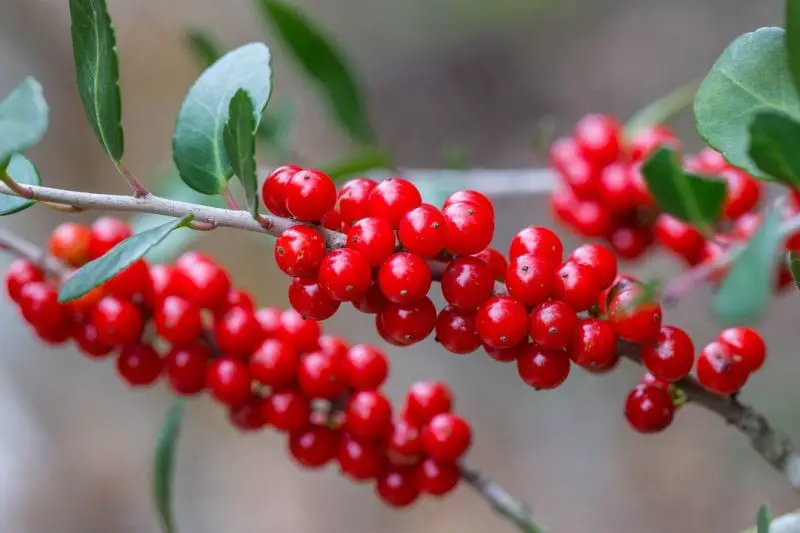
Weeping Holly is a unique cultivar known for its graceful, pendulous branches and elegant structure. It is often a hybrid based on Ilex aquifolium or related species. This evergreen tree features glossy green leaves and bright red berries that provide winter interest, especially against its cascading form.
Hardy in USDA zones 6 to 8, Ilex pendula prefers fertile, well-drained soils and full sun to partial shade. It can tolerate urban conditions and is moderately drought-tolerant once established. Its weeping shape may need staking in early growth to guide its structure.
This cultivar is highly valued as a specimen tree, especially in formal gardens or near entryways. Pruning is generally limited to removing crossed branches or controlling height. Regular watering and mulching help preserve moisture and support root health during dry spells.
Ilex longipes (Georgia Holly)
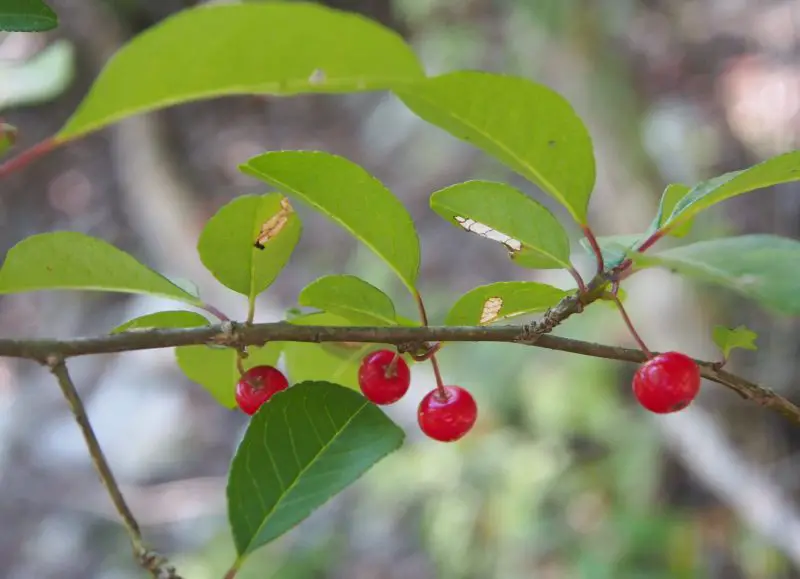
Georgia Holly is a deciduous holly species native to the southeastern United States. It typically grows as a large shrub or small tree, reaching 10 to 20 feet tall. The glossy green leaves are oval and may have slight serrations. In fall, it produces bright red berries that attract birds and wildlife.
This species grows well in USDA zones 6 to 9 and prefers acidic, moist, well-drained soils. It thrives in full sun to partial shade and is tolerant of both drought and periodic flooding. Its natural range includes woodlands and upland pine forests, where it blends well into native plantings.
Georgia Holly is useful in naturalized landscapes, wildlife gardens, and restoration projects. It requires little maintenance but benefits from occasional pruning to maintain form. Provide a nearby male plant for pollination if fruiting is desired, and apply mulch to retain moisture.






